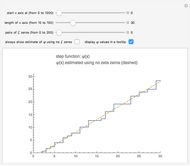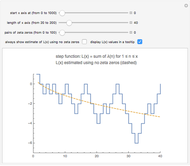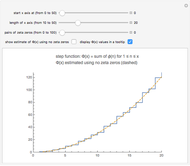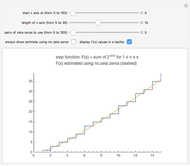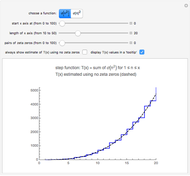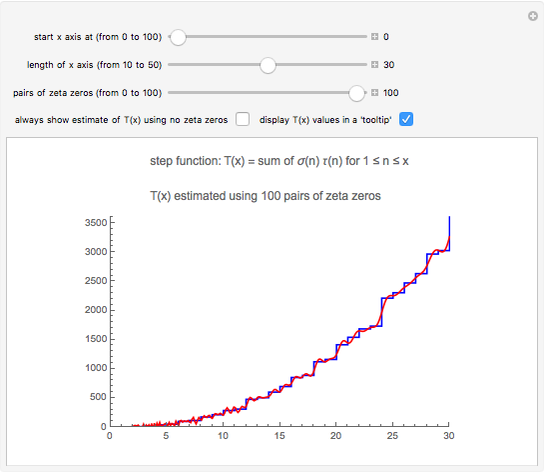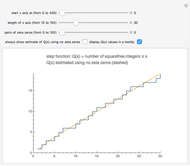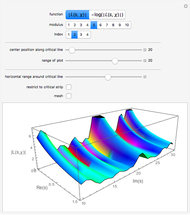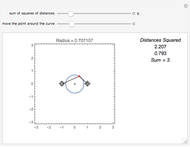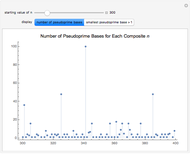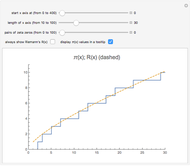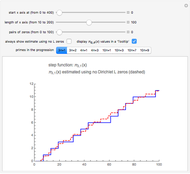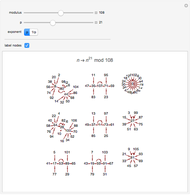Dirichlet L-Functions and Their Zeros

Requires a Wolfram Notebook System
Interact on desktop, mobile and cloud with the free Wolfram Player or other Wolfram Language products.
Dirichlet  -functions are important in number theory. For example,
-functions are important in number theory. For example,  -functions are used to prove Dirichlet's theorem, which states that the arithmetic progression
-functions are used to prove Dirichlet's theorem, which states that the arithmetic progression  (
( ) contains infinitely many primes, provided
) contains infinitely many primes, provided  and
and  are relatively prime. The zeros of
are relatively prime. The zeros of  -functions can even be used to count how many primes less than
-functions can even be used to count how many primes less than  there are in arithmetic progressions.
there are in arithmetic progressions.
Contributed by: Robert Baillie (March 2011)
Open content licensed under CC BY-NC-SA
Snapshots
Details
Snapshot 1: the graph of the Dirichlet  -function
-function  for
for  ; the corresponding Dirichlet character
; the corresponding Dirichlet character  has only real values, so the zeros of the
has only real values, so the zeros of the  -function occur in conjugate pairs
-function occur in conjugate pairs 
Snapshot 2: the graph of  ; the corresponding Dirichlet character
; the corresponding Dirichlet character  sometimes has complex values, so the zeros do not occur in conjugate pairs
sometimes has complex values, so the zeros do not occur in conjugate pairs
Introduction:
Let  be a positive integer and suppose that
be a positive integer and suppose that  and
and  are relatively prime (i.e.,
are relatively prime (i.e.,  and
and  have no common factor greater than 1). Then Dirichlet's theorem says that the arithmetic progression
have no common factor greater than 1). Then Dirichlet's theorem says that the arithmetic progression  has infinitely many primes. Dirichlet's theorem is proved in [1] by using Dirichlet characters and
has infinitely many primes. Dirichlet's theorem is proved in [1] by using Dirichlet characters and  -functions. The number of integers between 1 and
-functions. The number of integers between 1 and  that are relatively prime to
that are relatively prime to  is given by
is given by  , where
, where  is Euler's phi, the totient function.
is Euler's phi, the totient function.
For example, if  , then
, then  . There are four integers between 1 and 10 that are relatively prime to
. There are four integers between 1 and 10 that are relatively prime to  :
:  ,
,  ,
,  , and
, and  Therefore, each of the arithmetic progressions
Therefore, each of the arithmetic progressions  ,
,  ,
,  , and
, and  contains infinitely many primes, as
contains infinitely many primes, as  takes the values
takes the values  .
.
Dirichlet Characters and  -functions:
-functions:
Given a positive integer  , a character function, usually denoted by
, a character function, usually denoted by  (the Greek letter chi), is a function defined on the numbers mod
(the Greek letter chi), is a function defined on the numbers mod  such that, for all
such that, for all  and
and  ,
,  ,
,  , and
, and  if and only if
if and only if  . There are
. There are  different characters mod
different characters mod  . See reference [2] for more information.
. See reference [2] for more information.
For example, there are four characters mod 5. The third Dirichlet character mod 5 (in Mathematica's numbering system) has the following values at  :
:  ,
,  ,
,  ,
,  , and
, and  . The second character mod 5 takes complex values:
. The second character mod 5 takes complex values:  ,
,  ,
,  ,
,  , and
, and 
 . (There are two other characters mod 5: the first is real; the fourth is complex.)
. (There are two other characters mod 5: the first is real; the fourth is complex.)
For any modulus  , there are at least two characters that take only real values, and usually some that take complex values.
, there are at least two characters that take only real values, and usually some that take complex values.
The "Table of Dirichlet Characters" Demonstration (see the related link below) lets you choose the modulus  and see the values of all of the
and see the values of all of the  different characters mod
different characters mod  .
.
For each character  , there is a corresponding Dirichlet
, there is a corresponding Dirichlet  -function of the complex variable
-function of the complex variable  , defined by
, defined by
(1)  .
.
In Mathematica notation, the Dirichlet  -function for the
-function for the  character
character  mod
mod  would be written as
would be written as
(2)  .
.
These series converge if  . With analytic continuation, these functions can be extended to the entire complex plane (see [3]).
. With analytic continuation, these functions can be extended to the entire complex plane (see [3]).
What do characters have to do with arithmetic progressions of the form  ? This formula from page 252 of reference [1] illustrates the connection. If
? This formula from page 252 of reference [1] illustrates the connection. If  is a character mod
is a character mod  , then
, then  , so we can factor out
, so we can factor out  from the sum in equation (1) above to get
from the sum in equation (1) above to get
 .
.
This shows how arithmetic progressions arise naturally from expressions involving characters and  -functions.
-functions.
Zeros of  -Functions:
-Functions:
If a character is real (that is, if all its values are real), then the complex zeros of the corresponding Dirichlet  -function occur in conjugate pairs. That is, if
-function occur in conjugate pairs. That is, if  is a zero, then so is
is a zero, then so is  . For example, we saw above that the third character mod 5 is real. The first two pairs of complex zeros for the corresponding Dirichlet
. For example, we saw above that the third character mod 5 is real. The first two pairs of complex zeros for the corresponding Dirichlet  -function
-function  are approximately
are approximately  and
and  . These are the four complex zeros whose imaginary parts are closest to 0.
. These are the four complex zeros whose imaginary parts are closest to 0.
On the other hand, if the character is complex, then the zeros of the corresponding  -function are generally not in conjugate pairs. For example, consider the second character mod 5, which takes complex values. The four zeros of
-function are generally not in conjugate pairs. For example, consider the second character mod 5, which takes complex values. The four zeros of  whose imaginary parts are closest to 0 are approximately
whose imaginary parts are closest to 0 are approximately  ,
,  ,
,  , and
, and  .
.
Dirichlet  -functions
-functions  also have real zeros (so-called trivial zeros) at
also have real zeros (so-called trivial zeros) at  , and at either the negative even integers
, and at either the negative even integers  , or at the negative odd integers
, or at the negative odd integers  .
.
The Demonstration "A Formula for Primes in Arithmetic Progressions" (see the related link below) uses zeros of Dirichlet  -functions to count the primes less than or equal to
-functions to count the primes less than or equal to  that are in various arithmetic progressions. Let
that are in various arithmetic progressions. Let  be an integer. Estimate the primes in an arithmetic progression that are less than or equal to
be an integer. Estimate the primes in an arithmetic progression that are less than or equal to  , then estimate the number that are less than or equal to
, then estimate the number that are less than or equal to  . If (after suitable rounding), these counts differ by 1, then
. If (after suitable rounding), these counts differ by 1, then  must be prime!
must be prime!
The Generalized Riemann Hypothesis:
The generalized Riemann hypothesis (GRH) is the unproven conjecture that any complex (that is, a so-called nontrivial) zero of  whose real part is between 0 and 1, actually has real part equal to 1/2.
whose real part is between 0 and 1, actually has real part equal to 1/2.
The GRH is a generalization of the more-famous Riemann hypothesis (RH), another unproven conjecture, that states that the complex zeros of the Riemann zeta function

all have real part equal to 1/2. For these reasons, the vertical line  in the complex plane is called the "critical" line.
in the complex plane is called the "critical" line.
The Riemann zeta function is often used to prove theorems about primes, and to estimate the size of  , the number of primes less than or equal to
, the number of primes less than or equal to  .
.
In a somewhat analogous way,  -functions are used to prove theorems, such as Dirichlet's theorem, about primes in arithmetic progressions, and to estimate how many primes there are in the arithmetic progression
-functions are used to prove theorems, such as Dirichlet's theorem, about primes in arithmetic progressions, and to estimate how many primes there are in the arithmetic progression  that are less than or equal to
that are less than or equal to  .
.
The RH and the GRH are among the most important unsolved problems in all of mathematics. They are important, among other reasons, because our current estimates of the number of primes less than or equal to  would become much more precise if the RH or the GRH could be proved.
would become much more precise if the RH or the GRH could be proved.
References:
[1] W. J. LeVeque, Topics in Number Theory, vol. 2, Reading, MA: Addison–Wesley, 1961 pp. 81–124.
[2] Dirichlet Characteron Wikipedia.
[3] Dirichlet L-Functionon Wikipedia.
[4] Generalized Riemann Hypothesison Wikipedia.
Permanent Citation









